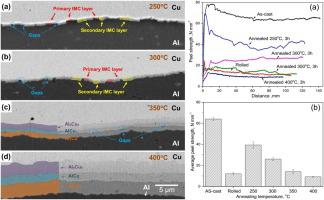当前位置:
X-MOL 学术
›
J. Mater. Process. Tech.
›
论文详情
Our official English website, www.x-mol.net, welcomes your feedback! (Note: you will need to create a separate account there.)
Effects of annealing temperature on the interfacial microstructure and bonding strength of Cu/Al clad sheets produced by twin-roll casting and rolling
Journal of Materials Processing Technology ( IF 6.3 ) Pub Date : 2020-11-01 , DOI: 10.1016/j.jmatprotec.2020.116804 Zhiping Mao , Jingpei Xie , Aiqin Wang , Wenyan Wang , Douqin Ma , Pei Liu
Journal of Materials Processing Technology ( IF 6.3 ) Pub Date : 2020-11-01 , DOI: 10.1016/j.jmatprotec.2020.116804 Zhiping Mao , Jingpei Xie , Aiqin Wang , Wenyan Wang , Douqin Ma , Pei Liu

|
Abstract In this paper, Cu/Al clad sheets were prepared by twin-roll casting and multi-pass cold rolling. Annealing treatment was performed at temperatures of 250 °C, 300 °C, 350 °C and 400 °C, separately. The influences of the annealing temperature on the interface layer structure, peel strength and peeled surface microstructure of the clad sheets were studied. The crack propagation behavior in the peeling process of the clad sheets was revealed, and the strengthening mechanism of the interface was explained. The results showed that the Cu/Al interface metallurgical bonding rate increased and the intermetallic compound layer thickness could be controlled within 550 nm after annealing at 250 °C, which encouraged more cracks to propagate along the Al matrix, and the average peel strength could reach approximately 39 N/mm. However, after high-temperature annealing treatment (350 °C and 400 °C), the clad sheet broke completely in the intermetallic compound layer, and a large number of cleavage fractures appeared, which caused the bonding strength to decrease sharply.
中文翻译:

退火温度对双辊连铸轧制Cu/Al复合板界面组织和结合强度的影响
摘要 本文采用双辊连铸和多道次冷轧方法制备了Cu/Al复合板。退火处理分别在 250°C、300°C、350°C 和 400°C 的温度下进行。研究了退火温度对复合板界面层结构、剥离强度和剥离表面微观结构的影响。揭示了复合板剥离过程中的裂纹扩展行为,解释了界面的强化机制。结果表明,250℃退火后Cu/Al界面冶金结合率提高,金属间化合物层厚度控制在550 nm以内,促使更多裂纹沿Al基体扩展,平均剥离强度可达约 39 N/mm。然而,
更新日期:2020-11-01
中文翻译:

退火温度对双辊连铸轧制Cu/Al复合板界面组织和结合强度的影响
摘要 本文采用双辊连铸和多道次冷轧方法制备了Cu/Al复合板。退火处理分别在 250°C、300°C、350°C 和 400°C 的温度下进行。研究了退火温度对复合板界面层结构、剥离强度和剥离表面微观结构的影响。揭示了复合板剥离过程中的裂纹扩展行为,解释了界面的强化机制。结果表明,250℃退火后Cu/Al界面冶金结合率提高,金属间化合物层厚度控制在550 nm以内,促使更多裂纹沿Al基体扩展,平均剥离强度可达约 39 N/mm。然而,


























 京公网安备 11010802027423号
京公网安备 11010802027423号